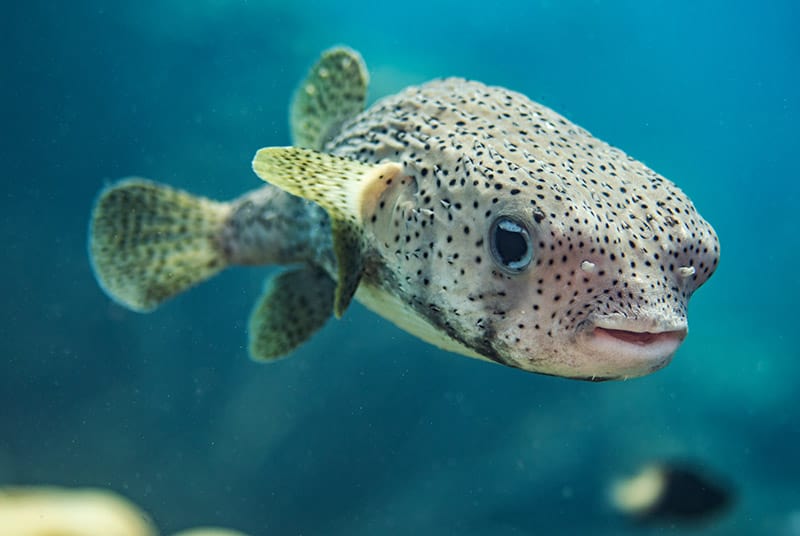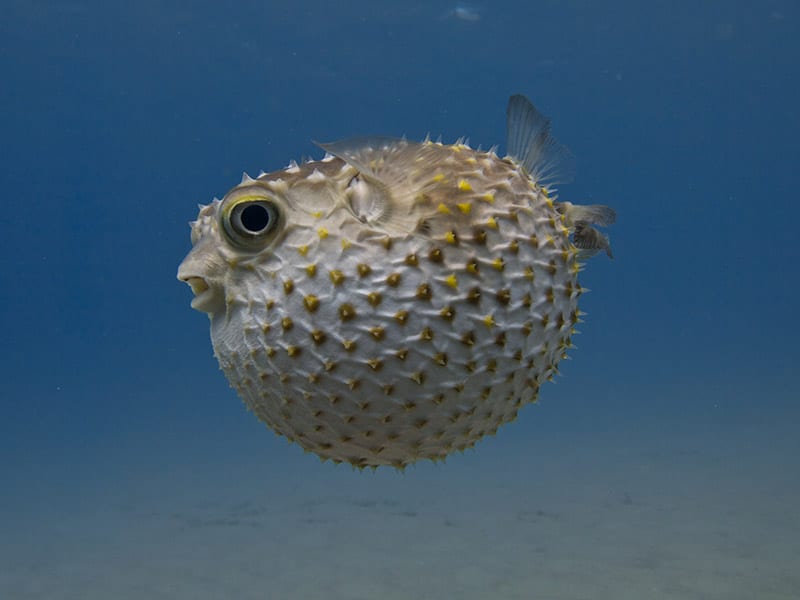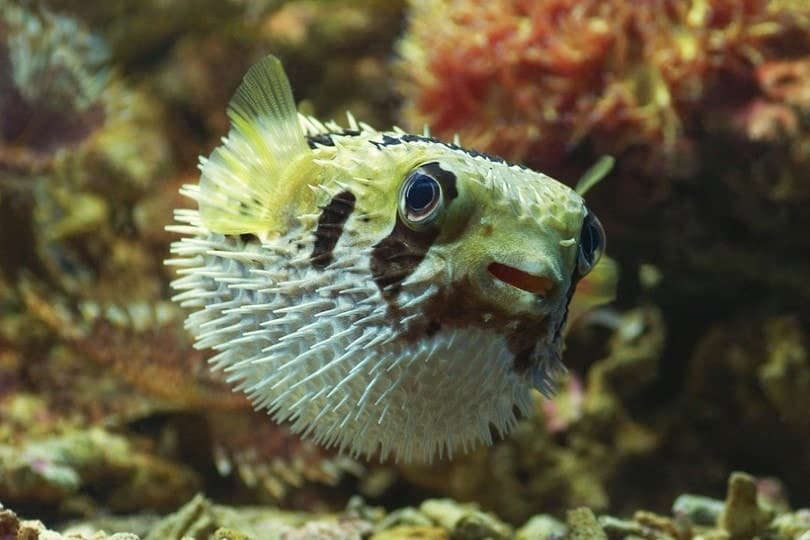This one is doing what most Porcupine Puffer or Porcupinefish do very well, (besides eating) it is puffing up! If threatened, they will fill themselves with air or water to become about 5 times their normal size! This one did it every time we moved it.
The Porcupine Puffer or Porcupinefish will become accustomed to being fed and will eventually look to their owners for food and will take it from your hand. Many times this fish will become so large the owners will get a separate aquarium for it!
- For more Information on keeping this fish see: Guide to a Happy, Healthy Marine Aquarium
Scientific Classification
| Kingdom: | Animalia |
| Phylum: | Chordata |
| Class: | Actinopterygii |
| Order: | Tetraodontiformes |
| Family: | Diodontidae |
| Genus: | Diodon |
| Species: | holocanthus |

Maintenance difficulty
Although the porcupine puffer or porcupinefish is easy to feed and generally hardy, they require special care and a special diet to stay healthy.
Maintenance
Puffers have strong teeth that grow throughout their lives. They need to be offered hard shelled live food often to keep their teeth worn down. For a better explanation and links to the practice of puffer dentistry (if needed) please read here. Because they eat a meaty diet and are often messy eaters, puffers will produce a large bio load on the biological filter of your aquarium requiring frequent water changes and good maintenance practices.
Habitat: Natural geographic location
Indo-Pacific: Southern Australia from central New South Wales to a similar latitude in Western Australia.
Foods
Puffers are primarily predatory fish in the wild, though they do graze on algae as well. Acceptable foods include shellfish, crustaceans and hard shelled foods such as snails. A large variety of all kinds of live and frozen meaty foods are best. It is best to feed small amounts several times a day. Some of the suggested frozen foods include prawn, crabs/crabs legs, bloodworms (live or frozen), blackworms (live or frozen), silversides, and mussels. Be sure to wash these foods thoroughly before feeding. Live foods can include snails, crabs, crayfish, shrimp (these are good for keeping their teeth trimmed), and earthworms. Live fish will also be eaten but it is thought it may cause problems such as ‘fatty” liver and so should be fed sparingly or not at all.. Puffers are not picky eaters and will quickly become adapted to a variety of prepared aquarium foods and an occasional algae wafer. Flake food is not recommended. Even though they may eat it, puffers will not thrive on it.
Social Behaviors
Found commonly in shallow bays. Nocturnal. Occurs in small aggregations. In the aquarium, they can be aggressive among themselves, and any smaller fish may be eaten.
Sexual differences
Unknown.
Recommended light levels
No special requirements.

Temperature
No special requirements. Normal temperatures for marine fish is between 74 and 79 degrees Fahrenheit.
Length/Diameter of fish
Porcupine Puffer or Porcupinefish adults can grow to 28.0 cm (11 inches).
Minimum Tank Length/Size
A minimum 75 gallon aquarium is recommended.
Water Movement: Weak, Moderate, Strong
No special requirements.
Water Region: Top, Middle, Bottom
No special requirements.
Availability
This fish is available from time to time.
Popular Searches
- Beginner Fish – Saltwater fish for beginners
- Community Fish – Peaceful Saltwater fish
- Hardy Fish – Hardy Saltwater fish
Featured Image Credit: eshoot, Shutterstock
